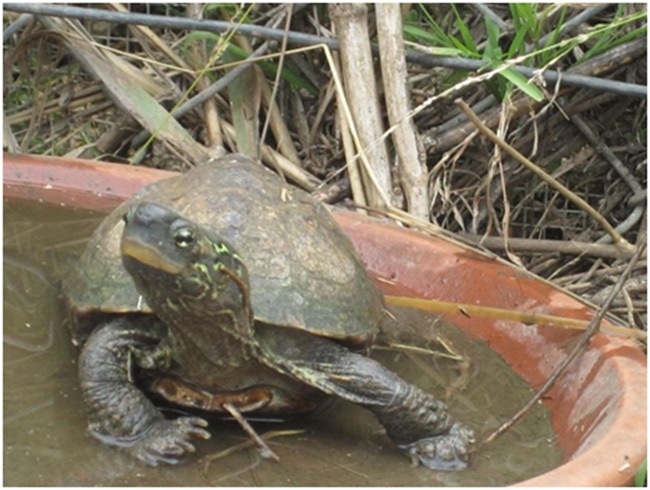|
Turtle and Tortoises Have Different Feeding Needs
While there are many variations on how to feed turtles and tortoises depending on the age and species, there are some basic rules that caretakers must observe in order to have healthy animals. It is amazing, but I find that many people do not even try to find out what the animal needs, but instead drops a piece of lettuce in front of it hoping that will suffice. How that myth got perpetrated is beyond us, but these little guys take a lot more care to live out their 100 years. The basic rule of thumb is turtles are carnivores and tortoises are vegetarians. Feed what they would find in the wild, i.e., would a turtle find dog food or hot dogs in the wild? Highly unusual! Would a tortoise find tofu or rice cakes in the wild? No! Turtles In general, turtles prefer live food. In the wild, they like to hunt ive worms, snails, rolly poly bugs and creepy crawlies. All taste delicious to a turtle. In captivity, we must provide live food for our turtles. Even if you are a vegetarian or are squeamish, you owe it to this little wild animal to provide healthy food. At the rescue, we do two things: we hunt down snails that have never been exposed to snail bait or pesticides. If you are not sure, keep the snails in a bucket with a mesh lid and feed them peanut butter for a few days. If they are not dead they are ok to feed to your turtles. More practically, we purchase superworms for the adult turtles and mealworms for the babies. We purchase 3000 superworms at a time, but you can buy containers of them at your local pet store. Feed as many as they can eat per sitting….sometimes as many as 12 – 15. Then do not feed again for a few days. Turtles also like grpapes, strawberries and greens like romaine or dandelion greens. Never feed your turtle cat food or dog food. It has too much protein and can cause long term damage. Water turtles are a different story. They can only eat under water. While they enjoy some of the above, the best diet is a prepared turtle food like Reptomin. Feed once every other day. Supplement the diet with live goldfish called feeder fish. These offer calcium because of their small bones. Some people say feeder fish are bad - we have water turtles that are more than 35 years old and they are fine. Of course, when they hibernate, turtles do not eat for three to six months. Tortoises Tortoises, by and large, are vegetarians. Most are green eaters (desert tortoises), but some can tolerate fruit (redfoots). Once you know what kind of a tortoise you have, you will be able to determine what is best. In the wild, tortoises do not get the fancy foods that we feed them. Regular feeding can cause what we call a pyramided shell – which is bumpy and unattractive (lack of sun is also a reason). For that reason, we recommend feeding every other day or every third day. This will make for an angry but healthier tortoise. Feed once a day in the morning. Do not feed spoiled food as they can get maggots and internal worms. Place the food on newspaper so that it can be tossed easily and so that they will not eat dirt or sand that can cause stones. We only feed grass hay (sulcatas usually only start eating after they move past the juvenile phase), dark leafy greens, dandelion greens (from your garden or the store), dark romaine and once in a while watermelon. Pumpkins are great during the fall when they are abundant. It’s thought that pumpkins are natural dewormers. Do not feed fruit to a desert tortoise or sulcata or other desert type tortoises. They are not programmed for it, and it can make then sick and give them diarrhea. In general tortoise poops are solid and damp. When in doubt peruse some web sites. Good ones include tortoise.com (ours), turtlehomes.org and tortoisetrust.org. Any food questions? For more information, e-mail American Tortoise Rescue at [email protected] or visit www.tortoise.com, Facebook at www.facebook.com/americantortoiserescue or on twitter @tortoiserescue About Us American Tortoise Rescue is a nonprofit founded in 1990 for the protection of all species of turtles and tortoises. We have rescued more than 4,000 since our inception. Foundlings that cannot be adopted because of ill health remain at the sanctuary for the remainder of their lives. ATR acts as a clearinghouse for information about turtle care. We work to abolish “live market” slaughter of turtles in the US and the cruel importation and exploitation of a variety of species for food or the pet trade. |
Please post an email with your comment or email [email protected] if you want a personal answer for a blog question! Archives
November 2023
Categories
All
|


 RSS Feed
RSS Feed